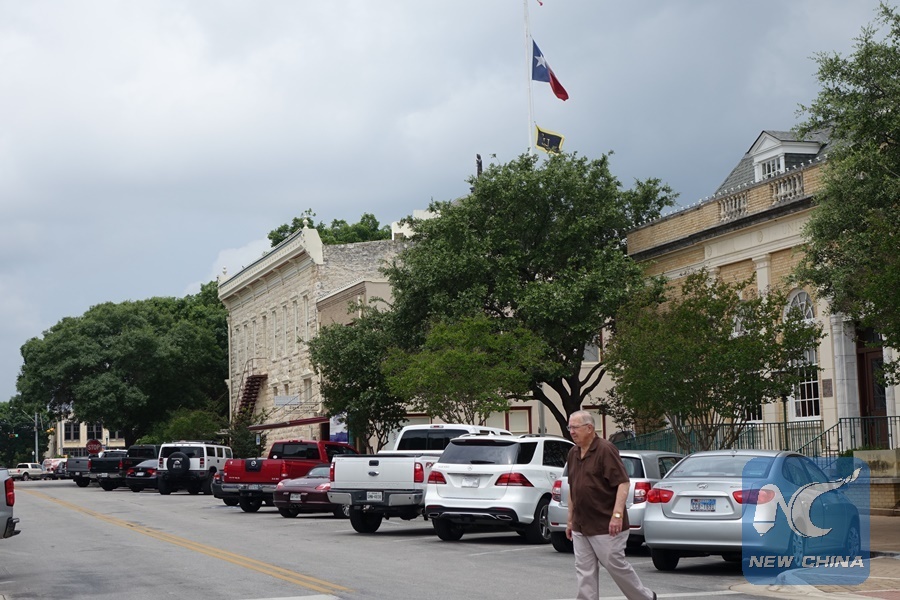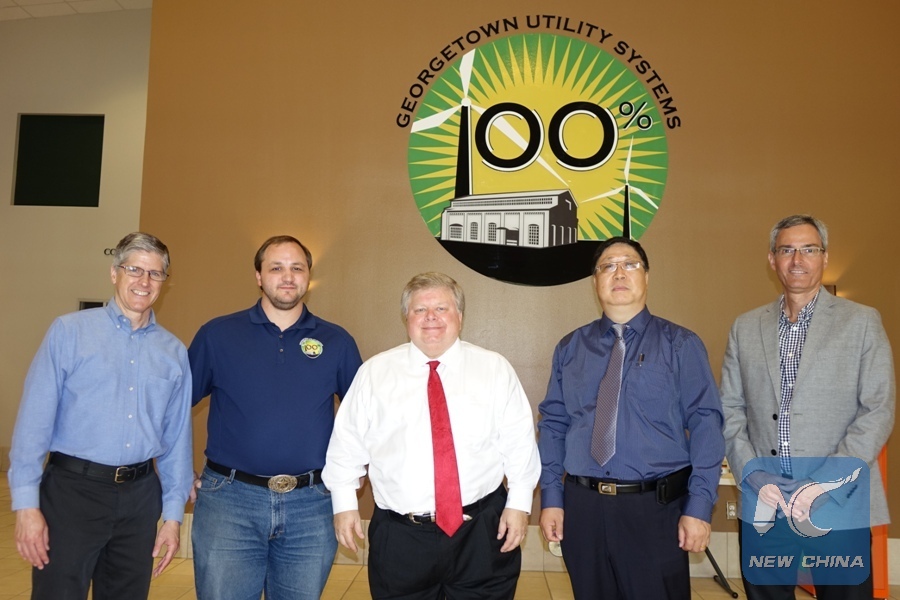Georgetown, a small city in the U.S. state of Texas, has a big dream to become greener by using 100 percent renewable energy next year, the first in the state and one of the few in the nation to be entirely powered by wind and solar energy.
Located about 40 kilometers north of the Lone Star state’s capital Austin, Georgetown, with a population of about 65,000, has witnessed the fastest growing in the United States thanks to the use of green energy over the past years.
In the eyes of Dale Ross, Georgetown’s mayor, the city is charming and unique and has a rich and proud history that goes back to nearly 170 years. Its pursuit of 100 percent renewable energy is just like icing on the cake.
A street view of Georgetown. (Xinhua/Zhang Yongxing)
“We are happy that we have not lost our small town charm, and we are happy to lead the way with regards to innovating for the future with our move to 100 percent renewable energy from our city-owned utility, and what we are doing is to save our residents’ money, to attract more big high tech companies to come to Georgetown, to develop our economy and to create a favorable environment for our people to work and live,” Ross told Xinhua in an exclusive interview recently.
Ross, who enjoyed a two-week-long visit to China last year, said proudly that Georgetown embraces renewable energy more aggressively than most Texas cities as it knows that such green energy can provide the city with much more cheaper and reliable electricity at a longer term, and help eliminate the risk of the fossil fuels-generated electricity’s long-term price fluctuation.
“This is a long-term source of power that creates cost certainty, brings economic development and helps our environment,” he said. “Maybe national gas price now is cheaper than green energy, but in the long term, during the 25 years …renewable energy will surely be cheaper.”
According to Chris Foster, manager of Georgetown’s resource planning and integration,the city had the idea of fully using green energy in 2008 and it took them years for a feasibility study and preparations.
Georgetown’s green energy plan includes a 144 megawatt agreement (in 2014) with a wind plant in northern Texas and another 150 megawatt agreement (in 2015) with a solar farm in western Texas.
The 25- and 20-year contracts allow the city to lock in low wholesale power rates and hedge against the price and regulatory uncertainty for energy produced by fossil-fuels, Foster said.
Georgetown Mayor Dale Ross (third from left) and Xinhua correspondent in Georgetown Utility Systems. (Xinhua/Zhang Yongxing)
The Spinning Spur 3 wind project by EDF (Electricite de France) Renewable Energy near the northern Texas city of Amarillo came online in September 2015 and is now producing 90 percent of Georgetown energy.
The solar farm, which belongs to a giant multinational solar energy company SunEdison, near the western Texas city of Fort Stockton, is scheduled to be operational in April 2017, and this means Georgetown will since then become a 100 percent renewable energy city. Sixty percent will be wind power while the rest will be from solar power.
Energy produced at the two sites is sent to central Texas via transmission lines. Electricity from generating plants across the state is managed every hour of every day by ERCOT, the Texas grid operator, to ensure that energy supply meets demand.
In recent years, Texas, which has its own separate power grid from the rest of the country, has begun updating its power grid to facilitate more renewable energy generation.
As part of the state’s Competitive Renewable Energy Zone program (CREZ), Texas has spent around 7 billion U.S. dollars building transmission lines to make far-removed wind and solar projects accessible to population centers in the central and eastern parts of the state.
Ross believes that wind and solar power can be mutually complementary as Texas is rich in both wind and solar power. The wind power is becoming more efficient and the solar power is getting better and better.
Wind farms generate most of the energy Georgetown needs in the evenings while solar energy will meet the city’s power need during the daylight hours. The combination of the wind and solar farm has resulted in lower cost power than any coal, gas, or nuclear bid the city has reviewed.
Texas, the nation’s second largest state, is actually a leader in clean energy development. Programs like state renewable portfolio standards from 1999 and federal tax credits from 2005 (Emerging Technology Fund) for renewable energies have encouraged the growth of wind and solar power generation. With such incentive programs, Texas’ energy demand met with wind power increased from one percent in 2001 to 10 percent in 2014.
Ross said that for the years to come, if the wind and solar plants produce more renewable power than the city consume, Georgetown will sell off the excess power into the ERCOT market.
Currently, Texas produces the most wind power of any U.S. state and Texas’ wind power consists of many wind farms with a total installed nameplate capacity of 17,713 MW from over 40 different projects. In 2015, wind power accounted for 11.7 percent of the electricity generated in the state.
In solar power, Texas is lagging behind the nation’s some other sunny southwestern states, but the state has great potentials in solar energy. In 2014, the state installed 129 megawatts of solar, ranking the eighth for the year nationally.
Nowadays,it seems that fossil fuels still dominates the energy sector, but green energy, like wind and solar power, will surely have a brighter future.
No doubt, Georgetown, a pioneer in taking the advantages of renewable energy, has seized the chance to develop itself by using 100 percent green energy.
“We have successfully built a bridge between the past and future which has allowed Georgetown to become the best city in the United States to live, work, play, raise kids, and retire,” Ross said.




